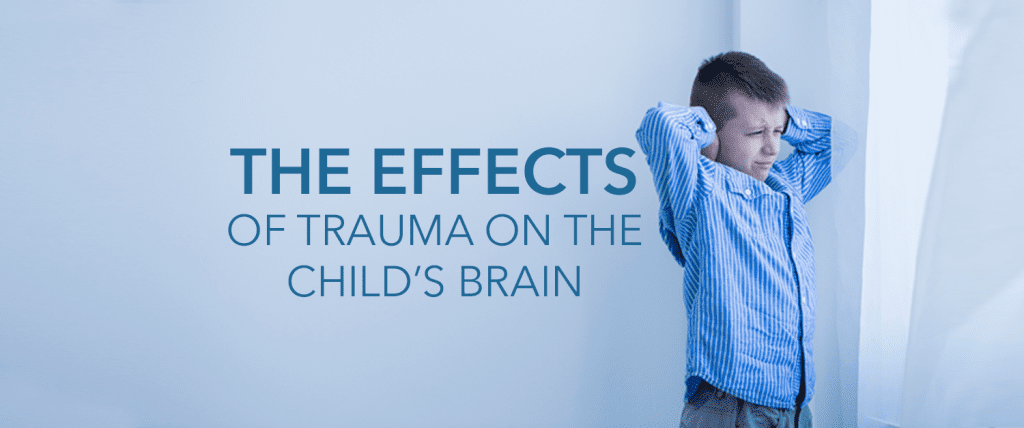Heather Wegner
Let’s spend a few minutes talking about the effects of trauma on the brains of children.
Many of us know that our experiences shape who we are, how we view ourselves, and how we view the world. Some of us reflect on our lives and notice pivotal moments that, for better or worse, impacted us. Perhaps it was a conversation with a friend where you felt valued and loved, or perhaps it was an assault that made you fearful to be alone in public. The same is true for children, though it impacts them differently than adults.
What many of us don’t know is that trauma impacts children on a neurological level. It shapes the way brain structures behave and how neurons wire together in the brain. In simple terms, the earlier and longer the child is exposed to trauma, the greater the influence on the brain.
Brain basics*
Let’s peek into the brain of a child. Inside the brain is the brainstem, limbic system, and cortex, which come together to form what some have called the “triune brain.” The brainstem helps with regulatory functions, such as breathing, heart rate, and sleep. It is also instrumental in mobilizing fight, flight, or freeze responses.
The limbic system works to create and regulate emotions, form relationships and attachments, and develop memories with meaning. One structure in the limbic system, called the hypothalamus, sends a hormone called cortisol throughout the body when we experience stress. In the short-term, this helps us respond to stressful situations. In the long-term, if we experience chronic stress and elevated levels of this hormone, or if our system becomes more reactive to minor stressors, it can become problematic. The amygdala is the part of the limbic system that is essential to the fear response and can activate survival responses of fight, flight, or freeze. The hippocampus is the part of the brain that turns events that we experience into memories, and works with the cortex to do so.
The cortex is the part of the brain that allows us to think, plan, organize, and problem-solve. It allows us to learn through our senses and remember body movements, such as learning to ride a bike. Within the cortex is the prefrontal cortex, which is an area where abstract thinking occurs, such as developing values and a sense of self, making judgments, or having empathy for others.
Effects of trauma on behavior
If you are the parent or guardian of a child who has had traumatic experiences, you might wonder what this means for your child’s behavior. There are probably times you struggle to make sense of your child’s behavior. It might be simple things that send them into a meltdown, such as letting them know you have to go to the grocery store or asking them to put away their backpack. In your mind, they might simply seem mad because they didn’t get what they wanted. In their mind, it is more likely an issue of survival and an inability to regulate emotions. Their brains might be highly reactive to minor stressors, and a simple direction may cause a cortisol spike that triggers fight, flight, or freeze, sending them into a dysregulated emotional state that is about survival and safety. This high activation of the brain stem and limbic system also means that it will be nearly impossible for your child to utilize their cortex (the part of the brain that helps them think and problem-solve). No wonder they react so strongly sometimes! In their brains, the situation is a matter of life and death!
What do I do with this information?
Now that you know that your child’s difficult behavior is because of the way trauma has impacted their brain, you may be wondering what to do about it. Did you know that a regulated amygdala can soothe a dysregulated amygdala? It is your job to share your calm, not join their chaos.
Practical tips
Please remember that kids cannot follow directions when they are dysregulated, so you have a very low chance of even getting them to do something simple like putting on their shoes.
1. The first step when a child is in a highly dysregulated emotional state is to help them soothe their limbic system.
• You can do this by getting down on their level (near them but not right in their face) and speaking in low and soothing tones.2. Connect to them by validating their emotions.
• (“I can tell you’re having a tough time right now.” “It looks like you might be feeling angry.” “This is really hard for you right now.”).
3. Remind them that they are safe with you.
• (“You’re safe with me.” “I’ll be here to help you through this.” “Let’s figure it out together.”).
4. Co-regulate with them.
• This means that you help them with a calming skill by joining with them (“Let’s do our deep belly breaths together. Ready? Breathe in…breathe out…nice, slow breaths. You’re doing great. Let’s do a few more together. I can see that your body is starting to calm down.”).
• This part might take some planning on the front end. If your child is in therapy, it might be helpful to create a “Big Feelings Plan” or a “Calm-Down Plan” where the child, parent, and therapist work together to create some skills and ideas that can be used during these moments. This works best when the child can practice the skills during times when they are already calm, so that they know how to use the skills when they are needed.
• Examples might include deep breathing, imagining being in a safe place, tensing then relaxing the muscles in the body, squeezing a stress ball, or repeating a simple word or phrase that evokes calm.
5. Connect by talking about the child’s feelings in the situation.
• This can be done once the child is calm, and may or may not be helpful to talk about right away. (“Can you share how you felt when I asked _____?” “What were you worried would happen?” “I can see why you got upset since you were worried about _____ happening.” “How do you think you could handle this next time?” “What can I do that can help you when you feel like this?”)
6. Remind them that you love them and will continue to love them no matter what.
7. If you have a task to return to, do it once they are calm.
• Remind them that the original task is something that is safe/healthy/positive to do. Make sure to reinforce their healthy response (or at least calmer response) to the task, and their completion of it. Depending on the situation, you can join with them in the task (for example, if it’s doing the dishes, they can wash and you can dry).
I hope these suggestions can help guide you as you learn to navigate the challenges of parenting children who have experienced trauma. If your child isn’t in therapy, that would be a great place to start. It can also be beneficial for parents to meet with a therapist who can help them manage their own stress and exhaustion levels. Parenting is hard, and you don’t have to do it alone. We’re here to help.
If your child has experienced trauma and would benefit from counseling, please contact us at 800-438-1772 or fill out our online Request Appointment form on our website to begin the healing process today.
*Adapted from Mindsight: The New Science of Personal Transformation by Dan Siegel




